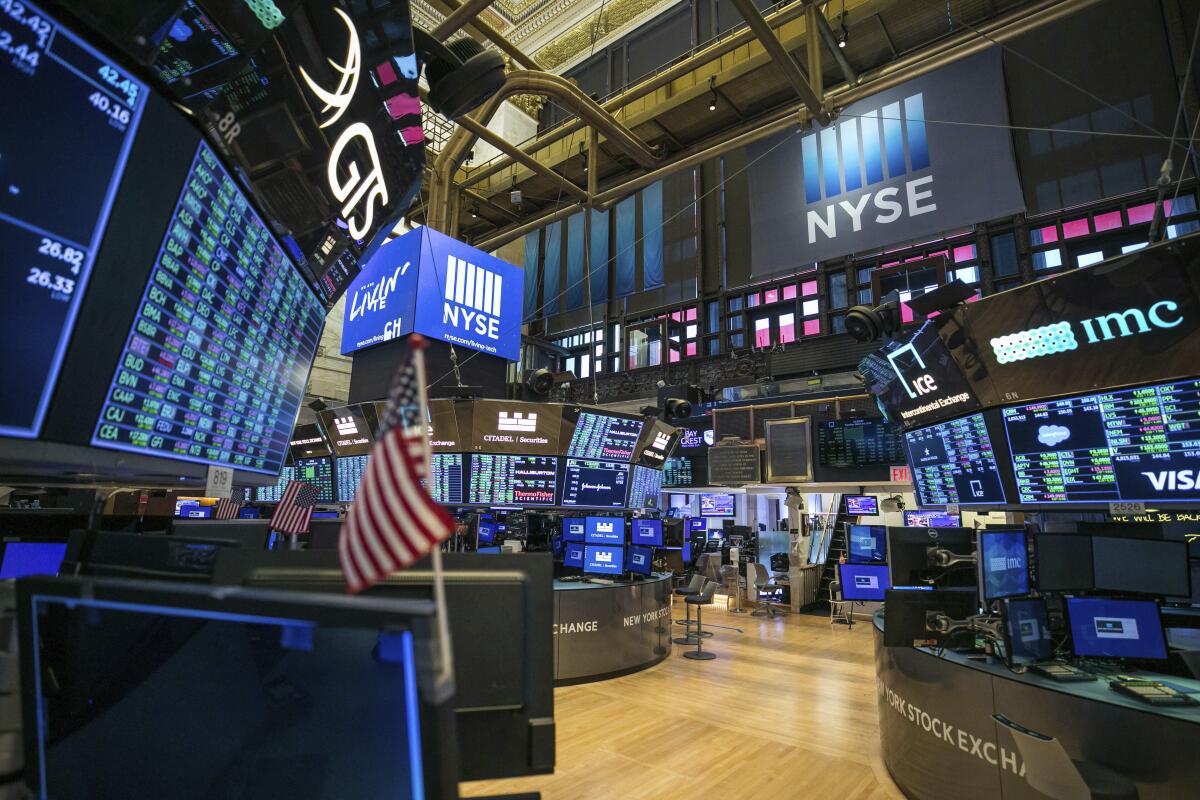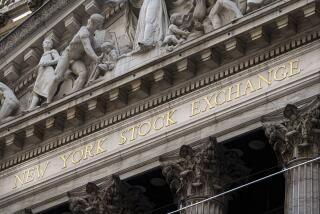Stocks jump 6% after Senate passes coronavirus relief bill

- Share via
U.S. stocks climbed for a third straight day Thursday as a massive coronavirus relief bill got closer to passage by Congress, with Wall Street taking some historically bad unemployment figures in stride.
The benchmark Standard & Poor’s 500 index rose 6.2%, bringing its three-day rally to 17.6%. The Dow Jones industrial average has risen an even steeper 21.3% since Monday, technically entering a bull market.
Nearly 3.3 million Americans applied for unemployment benefits last week, easily shattering the record set in 1982, as layoffs and business shutdowns sweep across the country.
Analysts said the market leaped Thursday because Wall Street knew the bad news on unemployment was coming. The gains this week came as Congress and the Federal Reserve promised an astonishing amount of aid for the economy and markets, hoping to support them as the coronavirus outbreak causes businesses to shut down.
“There is no sugarcoating these numbers — they are bad,” Jamie Cox, managing partner at Harris Financial Group, said of the jobless data. “Markets have had several days to digest what everyone knew was coming; therefore, the market response to these numbers may differ than what people might expect.”
Despite the big gains, the S&P 500 remains 22% below the record high it reached in February, and analysts expect more dire economic headlines — and market turbulence — in the days ahead.
Companies are also expected to report discouraging results in just a few weeks as earnings season begins. Very few have dared to issue forecasts capturing how big a hit the virus will inflict on their profits.
Rising expectations that Congress will approve an unprecedented rescue package for the economy have driven stocks higher this week. Late Wednesday, the Senate unanimously approved the $2.2-trillion plan, which includes direct payments to U.S. households and aid to hard-hit industries. The House of Representatives is expected to approve it Friday.
The prospect of a big financial shot in the arm for businesses and households helped offset some concerns about the steep job losses that the coronavirus has caused.
But if investors are going to maintain confidence, they still need to see stability in banks and, especially, in oil prices, because markets could be in for another slide if oil goes below $20 a barrel, said Andrew Slimmon, managing director and senior portfolio manager at Morgan Stanley Investment Management.
Benchmark U.S. oil slid 7.7% on Thursday to $22.60 a barrel. Goldman Sachs has forecast that it will fall well below $20 a barrel in the next two months because storage will be filled to the brim and wells will have to be shut down.
“I wouldn’t necessarily say that where the market was yesterday we won’t see that again,” Slimmon said. “There is bad news still to come.”
Investors say the market needs three main things to slow its breathtaking drop.
The first is already here: The Federal Reserve has slashed interest rates to nearly zero and offered to buy an unlimited amount of Treasurys to get lending markets running more smoothly. The second is making progress, as the economic rescue plan moves through Congress.
The third, though, is getting more concerning by the day: the accelerating spread of the virus.
The United States has more than 80,000 known cases, and the worldwide number of infections has topped half a million, according to Johns Hopkins University. The death toll has climbed to more than 23,000 people, while more than 120,000 have recovered.
For most people, the novel coronavirus causes mild or moderate symptoms, such as fever and a cough that clear up in two to three weeks. For some, especially older adults and people with preexisting health problems, it can cause more severe illness, including pneumonia, and death.
The yield on the 10-year Treasury fell to 0.83% from 0.85%. It had been as low as 0.77% just before the jobless report was released. Lower yields reflect dimmer expectations for economic growth and greater demand for low-risk assets.
Boeing continued to climb, rising 13.7% — the biggest gainer in the Dow — building on its Wednesday leap of more than 24%, in part on expectations that the aircraft manufacturer stands to gain from the congressional aid package.
The Dow was also adding to its gains this week. The index rose 1,351.62 points, or 6.4%, to 22,552.17. The Nasdaq climbed 413.24 points, or 5.6%, to 7,797.54. The S&P 500 rose 154.51 points to 2,630.07.
Despite the rally this week, analysts say further big drops are likely to be common until there have been enough sustained gains in the market to ease investors’ fear of further declines.
“Historically, you do test the bottom one, two, three times before you’re convinced it’s over, and then you build up again toward that viable rally,” said Quincy Krosby, chief market strategist at Prudential Financial. “What you have here, obviously, is a concern about how deep the recession is going to be and when are we going to come out.”
More to Read
Inside the business of entertainment
The Wide Shot brings you news, analysis and insights on everything from streaming wars to production — and what it all means for the future.
You may occasionally receive promotional content from the Los Angeles Times.










